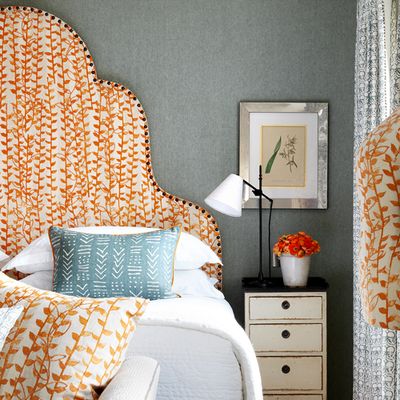
Expert Tips For Designing A Headboard
Walk into a bedroom and your eye is inevitably drawn to the bed. Dressed with plump cushions and tactile throws, the crowning glory is its headboard. Designing one for your home is easier than you think and could well be one of the easiest bespoke items to commission.
Start with thinking about the impact you want your headboard to have. “Headboards have always been a favourite feature of mine to create a statement in a room,” explains Kit Kemp. “Dramatic headboards make an inviting centrepiece and are a great way to introduce drama and detail. We always overscale the headboard to make an interesting feature. Use it as a picture to show off beautiful fabrics and detail, then build your scheme around it. Always think about texture and feel, use all your senses.”
Don’t be shy when it comes to sizing your headboard. “We always allow a couple of centimetres either side of the bed to accommodate the bedding, otherwise the headboard can look a bit tight once the bed is made up,” reveals Gail Tayor, founder of th2designs. “We also like the headboards to go down to the floor - again it adds to the feeling of luxury. Normally, we aim to fix the headboards back to the wall with a batten, as it is much more secure than fixing to a bed. If you don’t want to mark the wall, then our headboards can always be fitted to the bed base, if you prefer.”
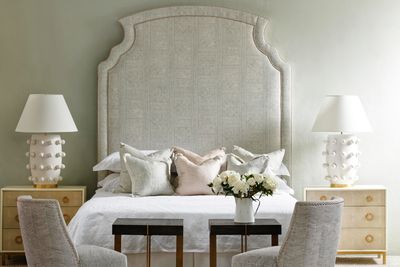
Sophie Paterson X Andrew Martin
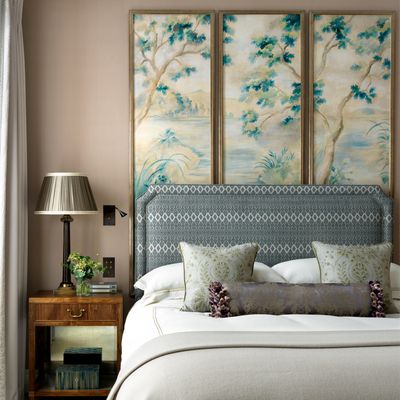
K&H Design
The fabric choice really depends on the scheme. If you’re using something plainer, tone and texture is key. Gail says: “Being in bed is one of life’s greatest luxuries and we love the cosy texture of wool, it is a very practical solution. Wool is elegant and timeless and it is so easy to add pattern and colour with throws and cushions. We recently did a dark green headboard with some studs and rested it against a dark green wall. It made a very dramatic statement in an otherwise plain room, and gold bedside lamps gave the contrast to balance the space.”
Detailed designs require a different approach. “When using bold patterns, it is important that they are of a similar language and varying scales throughout the room,” advises Kit. “Minimising the colour variation creates a dialogue between the fabrics, resulting in a harmonious scheme. I like to keep the curtains and walling quite plain so I can add colour and texture to the centre of the room. I will only use one large repeat, one small repeat and possibly a smaller geometric, otherwise it won’t be a restful experience, but stretching the imagination with colour and pattern is fun.”
Finishing touches are dependent on the fabric you choose. Gail loves leather piping on velvet headboards and bronze studs with pale fabrics. Whatever look you decide to go for, push your limit either in size or fabric and you won’t regret it. “I love a fully upholstered wall that we did some years ago the palest blue wool,” explains Gail. “It created a very balanced and symmetrical look but also a real hotel feel and still looks great now.”
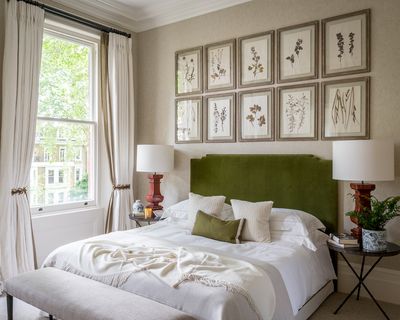
Kit Kemp
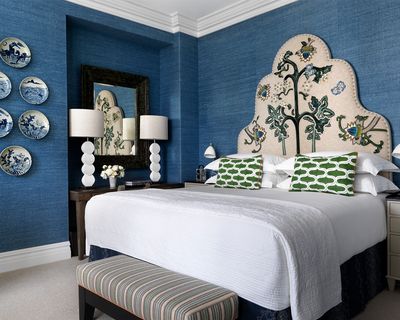
Kitesgrove
Inspired to design your own headboard? Here’s where to start:
1. How do I measure for my headboard?
Well, it isn’t as hard as you may think. If you go to an expert manufacturer, they’ll help guide you. “All of our headboards start from the top of the mattress up,” explains Sheryl Long of The Headboard Workshop. “All you need to establish is the size of your bed (the width) and how high from the top of your mattress you want the finished headboard to be.”
2. Do I mount it on the bed or the wall?
You can do either. Particularly tall or wide designs should wall mounted if they are able to be for a flush to the wall finish. “Mounting your headboard to the bed is also easy with our cleverly designed plywood moulded struts that can be adjusted to fit almost all beds,” reassures Sheryl.
3. Do I need to protect the fabric?
It is advisable. “With some fabrics costing upwards of £100 a metre or more, I would say that spending on fabric protector is a small cost for peace of mind,” explains Sheryl.
4. Should I pipe or stud a headboard?
In general, adding piping, buttons, fringes and most trims to any standard design will bring it to life.
DISCLAIMER: We endeavour to always credit the correct original source of every image we use. If you think a credit may be incorrect, please contact us at info@sheerluxe.com.
INSPIRATION CREDITS: KitKemp,com, Kitesgrove.com, K&HDesign.com, AndrewMartin.co.uk